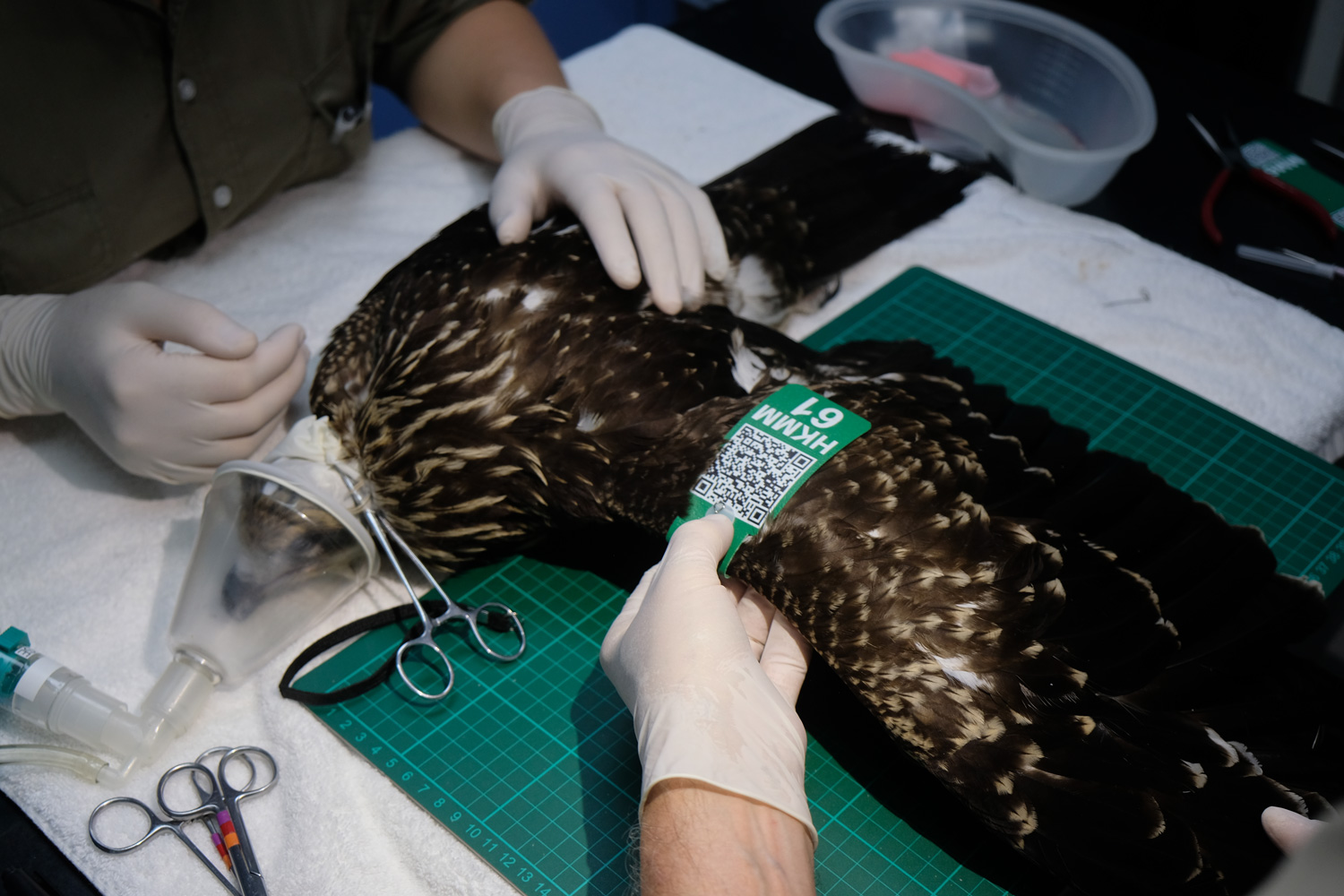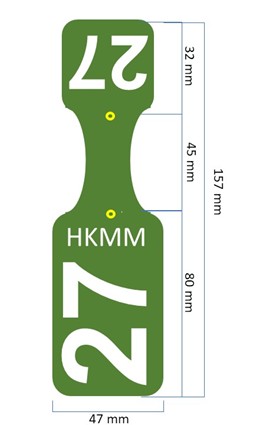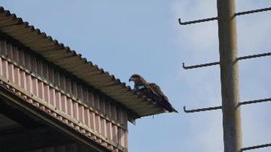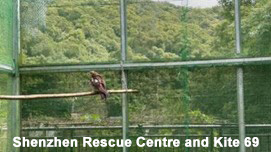
|
Background / Introduction The black kite is the most common diurnal raptor in Hong Kong, and a species that regularly turns up at the KFBG rescue centre. KFBG is the first organisation in Hong Kong to introduce wing tagging as a method for carrying out post-release monitoring of black kites, with the first wing tags being attached to a kite in July 2023. During the past 25 years of rescue work, KFBG has received 423 kites, of which 255 have been successfully released after their rescue and treatment: a commendable release rate by international wildlife rehabilitation standards of 60%. However, as is common with many centres, post-release survival data is lacking. Wing tagging is an effective and safe method for ecologists and conservationists to retrieve data about animal movements, migration, nesting/breeding patterns, roosting localities, growth rates, and territoriality. Rescue centres involved in wildlife rehabilitation and native release may consider this technique a useful method to monitor post-release survival and behaviour. |
 |
Wing tags attached to a related species in the UK (Photo: red kites, John Barrett) |
|
How can wing tags help to improve rehabilitation success?
Wing-tagging procedures 1. Health check and wing tag application Rehabilitation and release requirements are assessed for every bird according to the current KFBG guidelines. The rehabilitation and veterinary teams must be satisfied that kites are injury-free, disease-free and fit to survive in the wild prior to release. All kites arriving at KFBG undergo initial triage and stabilisation. Once stable, they are placed under anaesthetic, during which the following is carried out by a veterinarian:
During their stay at the rescue centre, kites are also fitted with a leg band according to British Trust for Ornithology standards. |
|
2. Wing tag design and application 
Wing tag mounted on a juvenile black kite (Credit: KFBG) 
Tag is fixed on the upper wing of the kite (Credit: KFBG) 
Position of the tag is checked to make sure it does not interfere with large feathers (Credit: KFBG) 
Pin is placed through the tag to hold in place (Credit: KFBG) 
During the attachment the kite is placed under anaesthetic to minimise stress (Credit: KFBG) |
|
KFBG wing tags have been designed specifically for the size and shape of black kites. They are made of green, UV-proof, soft, flexible, lightweight plastic canvas. The white lettering is also UV-proof, meaning it will not be degraded by continuous exposure to sunlight. The wing tags will carry the following information:
The tag number and QR code may not be visible at height. However, a photo taken by a member of the public may show the code, allowing the photographer to connect to the online form and fill in the sighting details. For further details about the KFBG Black Kite Wing Tagging Project, please click here “Please provide details of your sightings of wing-tagged kites” Your feedback is essential to our project, please help by filling the form below if you spot a kite with a wing tag. You will be greatly assisting our project to determine where the birds go and how long they live. |
Report a tagged kite (Please sign in Google account to view the following form)
|
RESULTS at April 2025 - one and a half years have passed and the project is yielding good post-release resighting data. Since the project began in July 2023, the tag design has been simplified significantly. The initial version included a QR code, but the new version features a larger, more visible number. As the project has gained more attention, the public has become aware that they need to report bird sightings through the KFBG website, making the QR code unnecessary. To date, thirteen kites are flying around Hong Kong with tags fitted (numbers: 06, 61, 91, 51, 63, 90, 30, 46, 69, 37, 93, 34, and "JC"). One kite has been recaptured, and one kite was found deceased by a member of the public. Below are some details about these birds: |
 |
|
Tagging DATE |
ID (K) |
TAG No |
MICROCHIP |
RING No |
RELEASE DATE |
RELEASE SITE |
|
20/07/2023 |
23006 |
06 |
713032073 |
GA00555 |
26/07/2023 |
Cyberport |
|
20/07/2023 |
22661 |
61 |
713032082 |
GA00554 |
15/08/2023 |
Cheung Chau |
|
21/07/2023 |
22791 |
91 |
713032090 |
GA00556 |
15/08/2023 |
Chai Wan |
|
14/08/2023 |
23151 |
51 |
713031741 |
GA00559 |
15/08/2023 |
Tseung Kwan O |
|
20/08/2023 |
23563 |
63 |
713031745 |
GA00560 |
23/08/2023 |
San Tin |
|
14/08/2023 |
20090 |
90 |
713031744 |
GA00529 |
11/09/2023 |
Mai Po |
|
13/09/2023 |
23730 |
30 |
713031730 |
GA00561 |
13/09/2023 |
Stanley |
|
27/03/2024 |
24346 |
46 |
713023318 |
GA00568 |
10/04/2024 |
KFBG |
|
27/06/2024 |
23569 |
69 |
713022977 |
GA00564 |
27/06/2024 |
Mai Po |
|
04/07/2024 |
25437 |
37 |
713023277 |
GA00573 |
05/07/2024 |
KFBG |
|
01/05/2024 |
24793 |
93 |
713023324 |
GA00570 |
08/07/2024 |
Sai Kung |
|
21/07/2023 |
22534 |
34 |
713032087 |
GA00557 |
27/10/2024 |
Mai Po |
|
27/11/2024 |
26804 |
JG |
713021118 |
GA00579 |
28/11/2024 |
KFBG |
In blue are the birds that have been re-sighted (for some multiple times) following the release.
Notable cases include Kite No. 69, which was admitted to KFBG in August 2023. This bird was then released on June 24, 2024, and was re-sighted on June 29, 2024. In July 2024, Kite No. 69 got into trouble in Shenzhen and was rescued by the Shenzhen Rescue Center. Throughout the rehabilitation process in China, KFBG and the Shenzhen rescue center maintained close communication.
 |
 |
Once the bird was deemed ready for release, some KFBG staff travelled to assist with the release on July 30, 2024. On August 21, 2024, Kite No. 69 was re-sighted on a roof in Tuen Mun by a member of the public.

